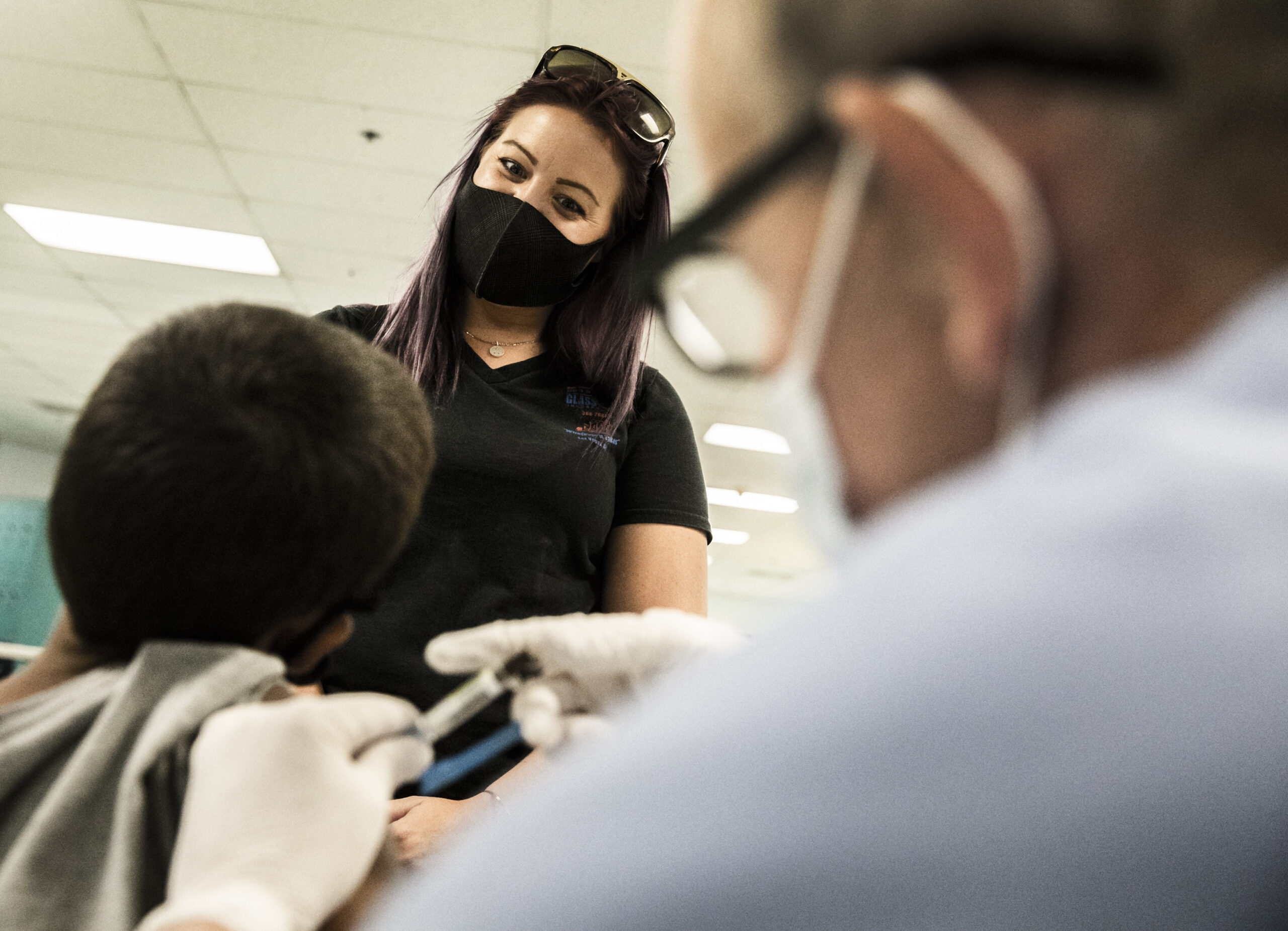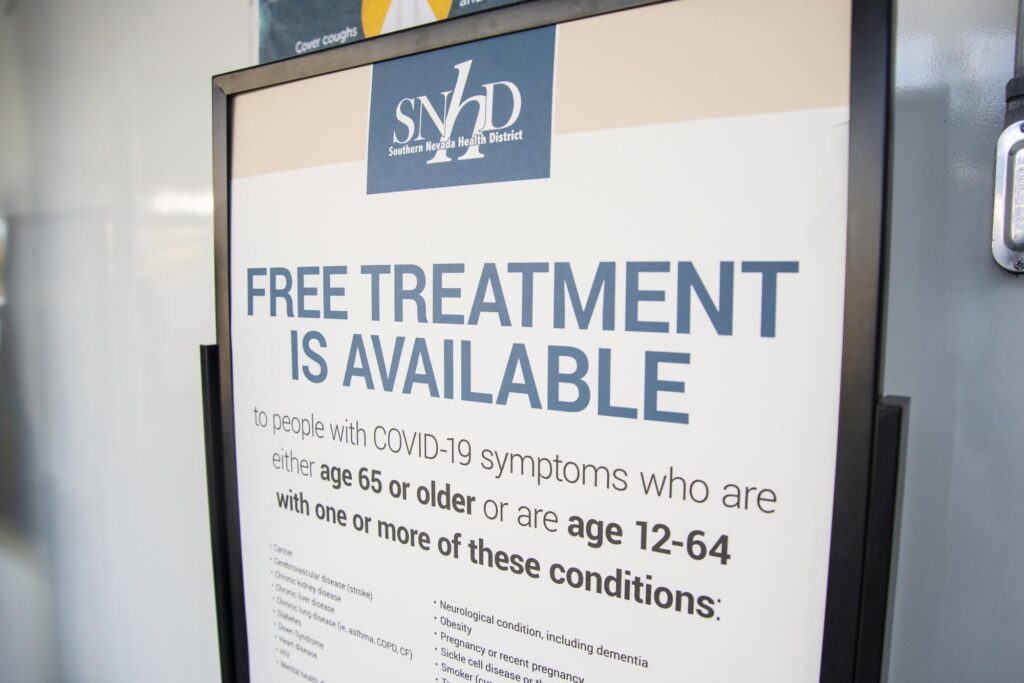COVID in Context: Expert says gauging personal risk key to navigating endemic phase

Welcome to COVID in Context, where staff at The Nevada Independent provide context and clarity on what’s happening with COVID-19 in Nevada.
COVID in Context will change depending on the situation at hand. If you have any questions, thoughts or suggestions, please reach out to [email protected], send me a direct message on Twitter, or submit them using this form.
For daily updates, check out our constantly updating data page and follow @nvindycovidbot on Twitter.
— Tabitha Mueller
As COVID-19 reaches endemic phase, vaccines a ‘huge piece of the puzzle’
Since last month, second COVID-19 vaccine booster doses have been made available. This week, several airlines along with Amtrak and other transportation service providers, have announced masks are now optional after a federal judge struck down the Biden administration’s rules on mask-wearing on airplanes and other public transportation. Reporter Tabitha Mueller hosted a live Q&A with Dr. Bayo Curry-Winchell to discuss the recent developments.
Curry-Winchell is a practicing family physician based in Reno who serves as regional clinical director for Caborn Health and medical director for Saint Mary’s Medical Group. She’s also a member of Gov. Steve Sisolak’s Medical Advisory Team on COVID-19.
Amid all the developments, Curry-Winchell said the pandemic has transitioned to an endemic (constant presence of a disease) and it’s important to adapt as needed. Although the cases have been decreasing, she highlighted the importance of getting vaccinated, receiving boosters and taking precautions by wearing masks or getting tested.
“It's about making that decision based on where you are going, what you are going to do and how you feel the overall risk is,” Curry-Winchell said. She recommended getting tested several days ahead of attending any events if concerned about transmitting COVID-19.
Curry-Winchell said the recent decrease in cases can be largely attributed to vaccination efforts. She added that the vaccines are also effective against BA.2 variant, and they can greatly increase protection from severe symptoms and death.
“BA.2 variant has a higher level of infectivity, meaning it is more transmissible,” she said. “But the good part is — now I say that with guardrails because every person experiences this disease differently — it doesn’t appear to cause severe disease or hospitalization.”
This week, Clark County reported 106 Omicron BA.2 cases, which is roughly 78 percent of the sample that was sequenced. The Southern Nevada Health District said reducing disease transmission through vaccination is one of the best ways to slow the emergence of new variants.
“When you take a step back and look at the history of vaccines, it really reinforces the importance as well as how helpful they have been in fighting this pandemic,” Curry-Winchell said. “And it’s definitely a huge piece of the puzzle to getting to where we are.”
According to the latest COVID State Project report from a consortium of university researchers, 13 percent of Americans 65 or older are completely unvaccinated, while an additional 14 percent have not received a booster. The unvaccinated and unboosted are disproportionately less educated, lower-income, rural and Republican.
The report also said the CDC data on vaccination rates are “significantly flawed” because they understate how many people are completely unvaccinated and how many people have received boosters, while overstating the number of individuals who only received a single dose. Many of the vaccinated but unboosted individuals indicated an openness to getting a booster, but cited obstacles or a lack of urgency to do so.
Curry-Winchell said that while at-home tests are wonderful tools for people who want to find out if they are positive for COVID, the fact that the results are not reported to the public health officials can skew the number of cases and make it difficult to accurately report positivity rates. Recently, the state has ordered more than 100,000 test kits so they can be made available for free at community centers and public health warehouses.
“One thing that is helpful — and I don’t believe you should hang your hat on it completely — is looking at hospitalization rates because I think that is a good indicator,” Curry-Winchell said. “There are many elements when it comes to looking at numbers and where to find your north star for guidance.”
The COVID State Project report stated that the main reasons cited by older Americans for being unvaccinated were worries about side effects and a lack of trust in the process by which the vaccines were developed.
“A myth that I commonly hear is that the vaccine will cause you to actually contract COVID,” Curry-Winchell said.
She explained that vaccines are similar to “recipes” that the body receives. Once vaccines are introduced, the body has a blueprint of how the virus works and how to fight it. And as people often experience symptoms such as fever or body aches, Curry-Winchell said that means bodies are gearing up to fight COVID-19.
The Nevada Department of Health and Human Services announced on April 5 that federal reimbursements would be curtailed and health providers will no longer be reimbursed for providing COVID-19 vaccines to uninsured and underinsured. The lack of federal funding could exacerbate existing disparities in health and financial security.
“I worry that people will not actually seek out testing because they can’t afford it,” Curry-Winchell said. “Especially with this financial barrier, people will stay at home when they might actually have symptoms that lead to a need for a higher level of care such as hospitalization.”
She said that while there are still lots of resources such as the Community Health Alliance in Reno, it can be difficult for people to know where to go. She stressed the need for an increase and diversification of ways people can learn about such resources because not everyone has access to the same information channels.
Curry-Winchell said finding “trusted messengers” such as pastors or priests can be the key to addressing mistrust in public health. She also stressed the need for more doctors of color and different genders so individuals can build rapport and feel connected with those who deliver health care information.
“Even before the pandemic, there are certain groups that have really experienced terrible things when it comes to public health,” Curry-Winchell said. “So there’s a need for ongoing health literacy and understanding of what has happened in the past, how you acknowledge it and how you provide new information moving forward because that’s how you are going to build trust.”
— Da Yeon Eom
Understanding the numbers
The number of new COVID-19 cases reported on average each day is down from last week, remaining well below the Omicron peak.
As of Monday, 119 new cases were reported on average each day over the last two weeks, down from 129 one week prior. That number is significantly less than the highest point of the winter Omicron surge, 6,410, which the state hit on Jan. 24.
The pace of vaccine distribution in Nevada is dropping slightly, with a 0.46 percent decrease in doses of the COVID-19 vaccine administered week-over-week compared with a 2 percent increase over the first week of January.
As of Monday, more than 85 percent of Nevadans have been either partially or fully vaccinated against COVID-19, with 30.8 percent fully vaccinated but with no booster and 14 percent fully vaccinated with a booster.
Since vaccinations became available in December 2020, more than 2 million Nevadans have received at least one dose of the COVID-19 vaccine, more than 1.7 million have been fully vaccinated and more than 766,000 people have received the booster.
A report from the COVID States Project released Friday warns that the Centers for Disease Control and Prevention’s data on vaccinations likely understates the number of people who are completely vaccinated and the number of people who have received boosters, and overstates the number of people who have received one dose of the vaccine.
Researchers with the project said that the errors likely stem from the CDC attributing booster shots as first shots because of poor vaccination record linkages.
The latest wastewater sampling data from the Southern Nevada Water Authority shows decreased concentrations of the virus from sites in unincorporated Clark County, Las Vegas, North Las Vegas and Henderson. Concentration levels from samples taken at sites in Boulder City remained the same as last week.
Overall, the concentration levels in Southern Nevada are lower than those seen at the peak of the Omicron surge in January.
Though concentrations of the virus in wastewater sampling in Washoe County showed some increases, the levels remain lower than those tracked during the peak of the Omicron wave.
— Tabitha Mueller

News you can use
Proof of vaccination
If you got your vaccine in Nevada, you can now access and download your COVID-19 vaccination records through the state’s immunization information system here.
If you receive an error message as you try to sign into the system, call 1-800-401-0946 or email [email protected].
Searching for COVID-19 testing and treatment options?
The Nevada Hospital Association has reported that there are free therapies available throughout Nevada for COVID-19 positive patients, including Evusheld, Sotrovimab, Paxlovid, Molnupiavir, and soon Bebtelovimab.
Patients can complete the pre-screening tool at https://nevadacovidtreatment.com/ or call 800-401-0946 (7 a.m. - 8 p.m. seven days a week) to locate and schedule these treatments.
For those looking for testing, individuals should get tested at testing sites, not hospital emergency departments.
To find a testing site in Nevada, including pharmacies, head on over to the state’s COVID-19 test site finder.
Rapid Tests
Here's the link to order free at-home COVID-19 tests through the United States Postal Service.
Residential households can now order up to two sets of four free at-home tests for a total of eight free at-home tests per household.
The United States Postal Service announced in March that more than 270 million free tests have been sent to nearly 70 million households since the initiative launched in mid-January.
As part of a federal effort, private insurance companies will cover at-home test kits purchased at pharmacies. Companies will cover up to eight kits per month, depending on the number of people on a health plan.
Here’s a guide for getting your over-the-counter COVID-19 test reimbursed.
Updated COVID-19 Guidelines
The Centers for Disease Control and Prevention updated its COVID-19 guidelines, relying less on new cases to determine risk levels and instead focusing on a combination of three metrics: new COVID-related hospital admissions, percentage of hospital beds occupied by COVID-19 patients and new cases per 100,000 people.
The community levels of COVID-19 are broken into low, medium and high categories.
Recommendations for counties falling within the categories are as follows:
- Low: Stay up-to-date with COVID-19 vaccines and get tested if you have symptoms
- Medium: For those at high risk for severe illness discuss precautions, talk with a health care provider, get tested if you have symptoms and stay up-to-date on COVID-19 vaccinations.
- High: Wear a mask in indoor public places, stay up-to-date with COVID-19 vaccines and get tested if you have symptoms.
As of Thursday, under the new guidelines, all of Nevada’s counties fall within the “low” COVID-19 community risk level category.
For complete guidelines and recommendations surrounding quarantine and isolation guidelines, head over to the CDC’s COVID-19 Quarantine and Isolation page.
What we’re reading
The Biden administration is set to appeal a federal judge’s decision that struck down the public transportation mask mandate. The Washington Post has the story.
Politico’s Megan Messerly details how worries surrounding the COVID vaccine are beginning to spill over into other immunizations, which public health experts fear could lead to preventable and potentially fatal diseases becoming more prevalent.
Amid a rise of COVID-19 cases in Milwaukee, the city’s school district announced it would be mandating mask-wearing just one day after it had moved to a mask-optional policy.
As cases of COVID-19 slowly uptick driven by the Omicron subvariant known as BA.2, the White House COVID-19 response coordinator Dr. Ashish K. Jha, told the “Today” show that hospitalizations “are the lowest they’ve been in the entire pandemic.” Though health officials have to monitor the situation closely, Jha added that he does not believe Americans need to be “excessively concerned.”

